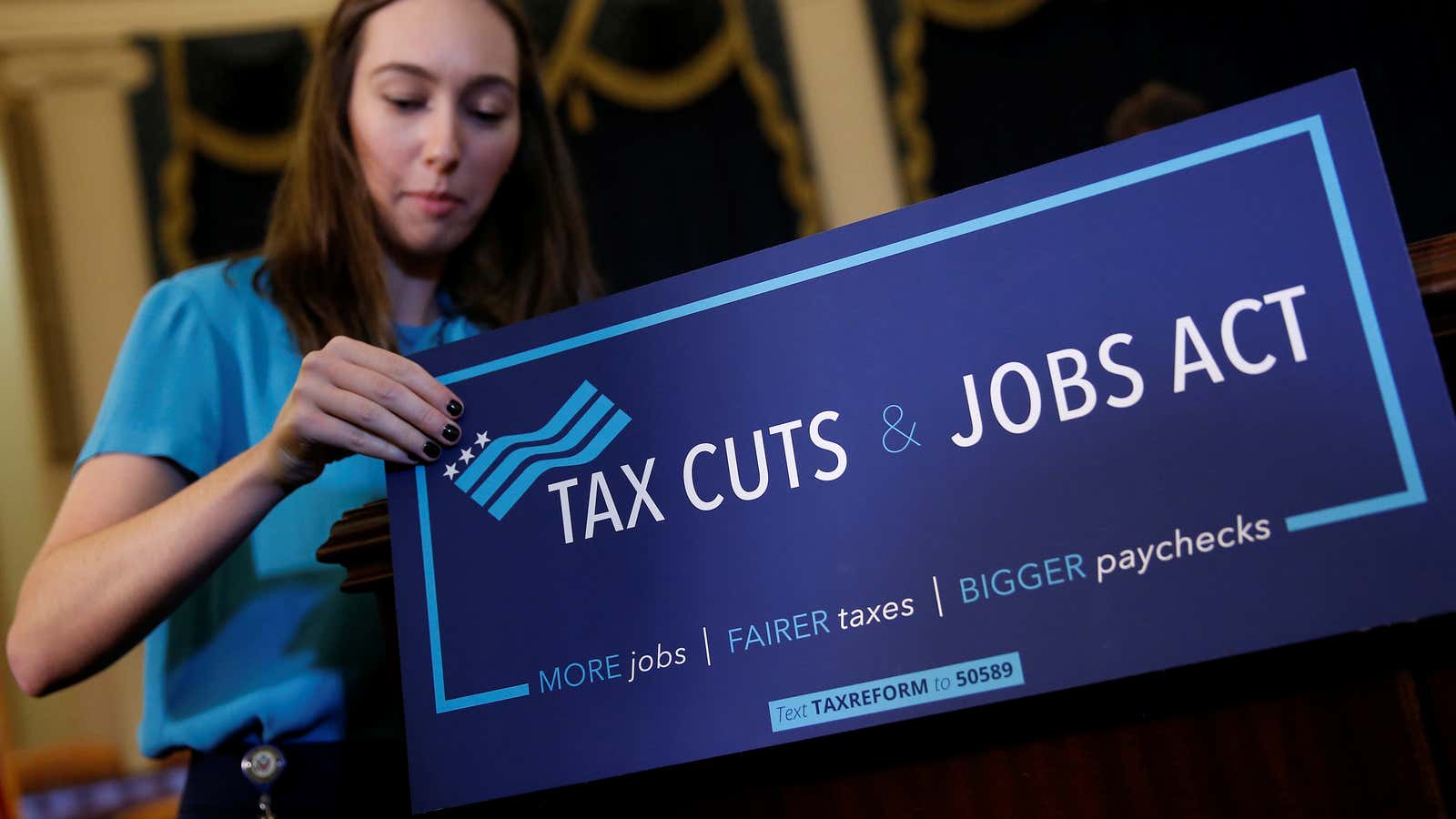A new narrative has taken hold in America that the rich aren’t paying their fair share of taxes. Normally, notions of fairness are subjective, and despite stories of Warren Buffett’s secretary paying more tax than he does, most estimates show the rich pay a higher tax rate on their income compared to everyone else. Perhaps the rich should pay even more, but that is a question of values and budgetary needs.
But such nuances aren’t part of the new discourse over whether US taxes have become regressive, which follows an opinion story in the New York Times and a news story in the Washington Post. Both are based on data from a forthcoming book from Berkeley economists Emmanuel Saez and Gabriel Zucman, who are advising Massachusetts senator Elizabeth Warren on her plans for a wealth tax. Their estimates, based on the lasted round of tax cuts, project that in 2018 the top 400 earners paid taxes at a lower rate, 23% of their income, than the bottom 50%, who paid 24.2%.
The New York Times included a graphic that was widely shared, prompting predictable outrage about how unfair our tax system has become. But the figure left the economic profession scratching their heads. The estimates were at odds with all prior estimates, including those of the bipartisan, well-regarded Congressional Budget Office. One point of contention is how transfer payments—for example earned income tax credit or Social Security payments—are calculated. Jason Furman, who chaired the Council of Economic Advisers under president Barack Obama, believes transfers should be included in the calculations because it is a better estimate of money in people’s pockets and what they actually end up paying. When transfers are included, the tax code looks much more progressive.
Even more baffling to tax economists was the lack of clarity about how the new numbers were arrived at. Because 2018 tax data is not yet available, Saez’s and Zucman’s have estimated what taxes have been paid, but they provided scant details about how they have done this. Adding to the confusion, a few days later, David Splinter, an economist at the Congressional Joint Committee on Taxation, released a paper that also projected tax rates paid in 2018 and found the opposite result, that taxes had remained progressive.
Splinter included more detail than Saez and Zucman on his calculations but was unable to recreate their results based on their cited 2014 estimates, leading him to suspect they used a different method than they had in earlier papers. Zucman called Splinter’s results nonsense.
In an email to Quartz, Zucman said his estimates are based on methods outlined in earlier, peer reviewed work and he cited a Brookings paper that includes a high-level description of what they did. He says all his data and code will be made available on Oct. 14, beforethe book’s publication and points out that Splinter’s work has not been peer reviewed. Zucman did not answer a question about whether he felt his most recent work had undergone adequate peer review, though he did point out his similar work in the past had been published in top journals
Economic historian Phil Magness, a senior research fellow at the American Institute for Economic Research, argues it is irregular to share numbers that have not been fully vetted with media outlets. He writes:
These issues leave us with a highly unconventional approach to presenting and vetting new economic data. In preparing their new numbers for the Times, Saez and Zucman appear to have eschewed best practices for estimating the distribution of tax burdens over the population as found with the CBO, which has employed the same underlying methodology since 1979. They also sidestepped the normal scholarly vetting process for new data, such as posting a working paper that details their methods and data sources.
It is common for journalists to write about economic working papers that have not been formally peer reviewed. This means economic research can be covered faster since it can take years for the peer review process to play out. This has helped the economics profession gain more influence because its research can address pressing policy questions and draw media attention. But even working papers normally have been subject to some informal peer review, through presentations at seminars and comments from their authors’ colleagues. They also include detailed descriptions of their data and methods. Sharing estimates that have not gone through this process is unusual, especially when results are so different from all prior research.
A large share of the difference between Saez’s and Zucman’s latest results and Splinters’ estimates, which is similar to earlier work, comes down to how economists account for tax evasion among high earners and how they treat retirement account rollovers. Based on the information that is available, each economists’ approach to estimating taxes paid by high earners is probably defensible, depending on how you define income and what you think about unrealized capital gains. But the discrepancies suggest claiming that the rich pay less in taxes is, at the very least, a contentious statement that is open to interpretation.
The economics profession’s reputation has taken a beating lately and accuracy and transparency has never been more essential. As more populist economic policies—on subjects from rent control to trade wars—become mainstream, the expertise of economists is needed more than before. Restoring their credibility will require the profession to take a long, hard look how new research is treated and shared with the public. Journalists also need to rethink how they cover non-peer reviewed work, especially when the results appear too good to be true.
